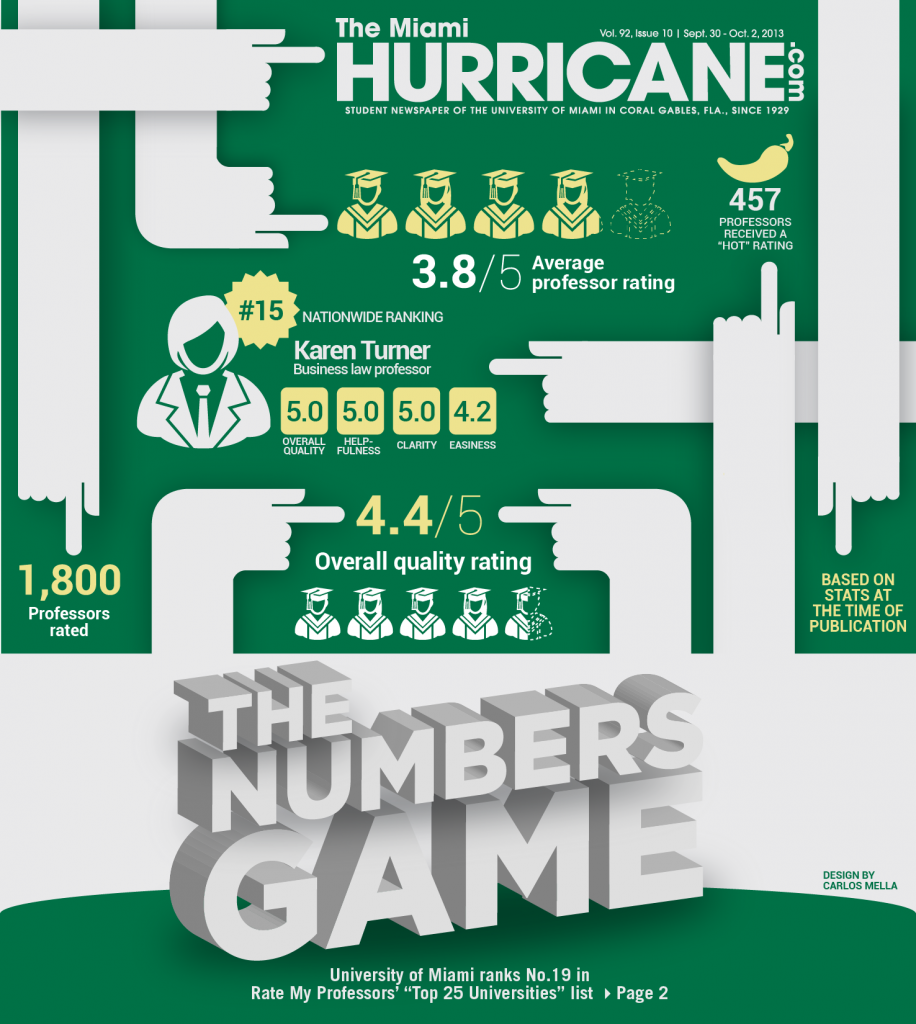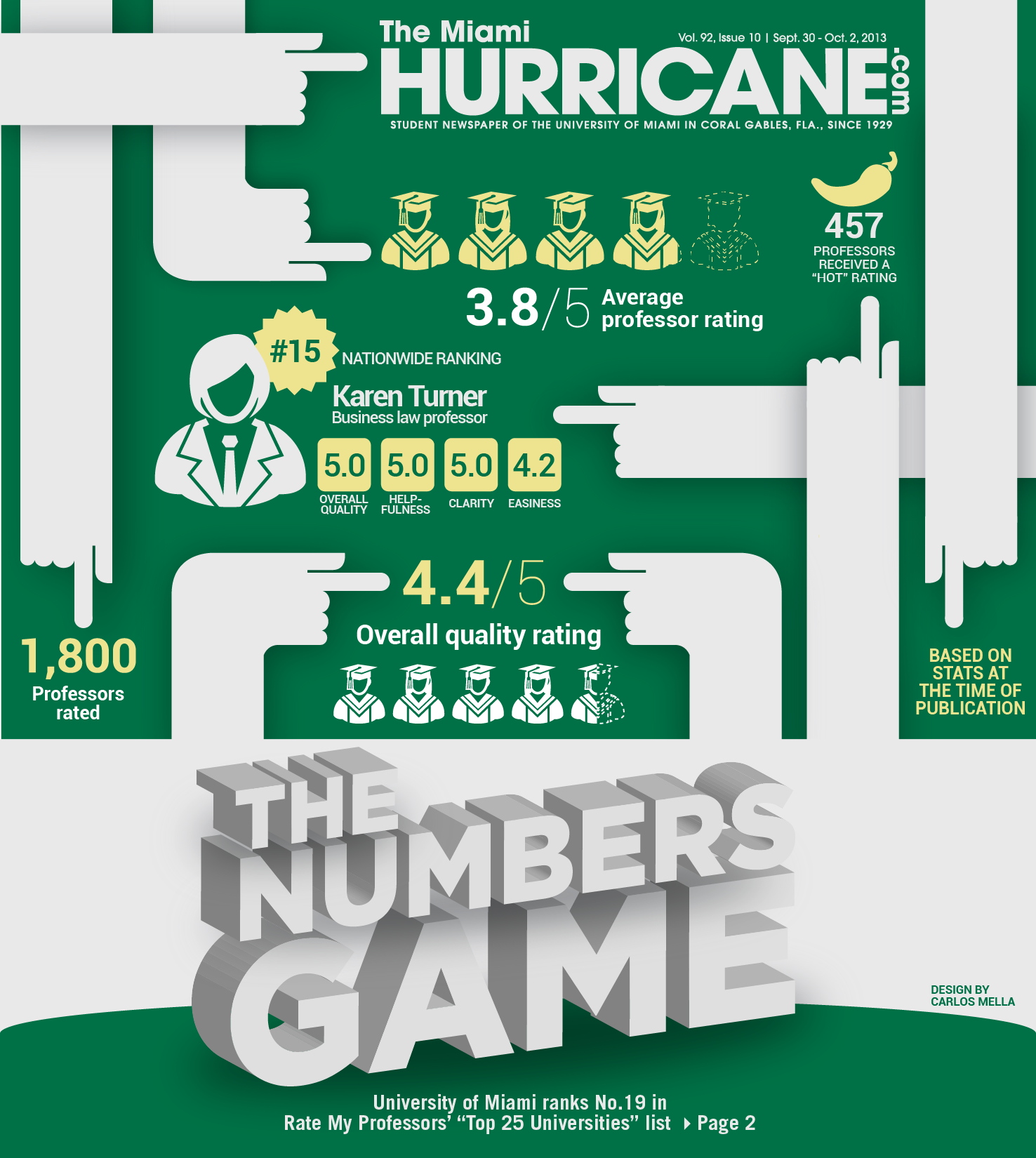
Near the end of each semester, sophomore Juliana Vallejo makes the annual visit to RateMyProfessors.com. She deciphers anonymous comments that range from helpful expectations of a course to extreme backlashes against a professor.
“I use it for making my class schedules,” she said. “It’s funny because people are like ‘I hate this teacher; he gave me an F.’ I don’t take these comments into consideration because it was probably [the student’s] fault.”
The University of Miami ranked No. 19 in the “Top 25 Universities” list, and Karen Turner, a business law professor in the School of Business, was the only UM professor to make the “Top 25 University Professors” list at No. 15. Rate My Professors publishes an annual college rankings list similar to U.S. News & World Report. It created a list of the top 25 national universities and professors.
Vallejo is one of six million college students that visit the student-driven site each month. Rate My Professors allows users to rank professors on different categories such as helpfulness, clarity and easiness. Moderated by mtvU, the rankings are entirely based on student-input. This is the first year that UM has made the list.
Carlo DiMarco, senior vice-president of strategic partnerships and development for mtvU, stresses that the rankings lists are solely based on audience feedback. The website has a statistician that works with the millions of comments to help determine the selections for the lists. Rate My Professors features on average more than 8,000 schools, 1.8 million professors and 15 million ratings.
Top of the class
For DiMarco, the website’s student-centered approach becomes a record of students’ experiences while on campus that prospective students can later use when they begin college.
“I hope that they use the site as a place to celebrate professors who are great,” he said. “There is story after story about professors making the mark.”
One of these professors that made the mark is Turner, who teaches business law at the undergraduate and graduate level. Business Insider magazine profiled her when the rankings were released on Sept. 17.
Turner first found out about Rate My Professors’ rankings list when Business Insider contacted her. She has never and does not plan to visit the site. She was, however, pleased to receive the award.
“It was based on student feedback; that’s why I considered this an honor,” she said.
Turner describes her teaching as interactive, yet traditional. She uses two blackboards, the physical classroom one and the online version – Blackboard.com. But for lectures and discussions, she prefers old-fashioned methods.
“Sometimes technology can be a detractor,” she said. “I write notes on the blackboard.”
The School of Business also awarded her several teaching awards at the undergraduate and graduate level. Turner incorporates her experience as an attorney, specializing in corporate and employment law, and the five years she spent as an associate faculty master at Stanford Residential College from 2002 to 2007.
“It gave me a unique perspective with the students than traditionally in the classroom,” she said.
Appy Ali, a senior majoring in economics and business law, found Turner’s teaching style engaging after taking the required introductory business law course for all business students.
“She shies away from PowerPoint,” Ali said. “I’ve had professors who have used technology a lot, and it does not catch my attention. Her lectures are organized and detailed with lots of examples.”
Turner’s class was Ali’s first exposure to the legal profession and inspired her to pursue a career in corporate law and declare a degree in business law. One of her best experiences in the class involved a project in which she had to draft a contract.
“It was a practical skill that I might not have realized as a freshmen, but as a senior looking to apply to jobs,” she said.
Ali recently signed on to work with Barclays Investment Bank in New York City in the compliance department. Turner helped Ali get to this point.
“She guided me in terms of what I should do at UM and as a post-graduate,” Ali said.
Methodology
The methodology is based on a weighted average of the past three years worth of ratings, with more emphasis put on recent years. Using the weighted score, professors are ranked from high to low. Only professors with 30 ratings or more are included to provide statistical significance.
School size does not affect the outcome of the lists, nor does it give professors from larger schools an advantage over those from smaller schools.
The ratings have scores for categories which include helpfulness, clarity, easiness and rater interest. The professor’s “Overall Quality” rating – the basis for the rankings list – is determined by equal weighting of the clarity and helpfulness category. The ratings are ranked from 1 (the lowest) to 5 (the highest).
Rate My Professors also includes a category for the professor’s level of physical attractiveness indicated by a red chili pepper.
“It’s an anecdotal piece and does not influence the score,” DiMarco said.
School rankings are similar to professor rankings. The website includes both the Overall School Rating, which is an average of its campus ratings. Both the campus and professor rating are equally averaged into the final score.
UM has a 3.79 professor average and an Overall Quality campus rating of 4.4. The campus ratings are divided into sub-categories such as reputation, clubs, food and student happiness. There are 1,800 UM professors who have been rated.
Happy medium
Despite all the manipulations with numbers, the main function of Rate My Professor is to help students choose their professors.
Ali and a fellow business student, senior Raymond Luo, have also used Rate My Professors to choose classes and find the best professors. Luo in particular has shared his opinions about professors.
“I’ve been honest about my experience,” Luo said. “I was not going to be just positive or negative, but give an overall idea of the content and professor.”
Not all ratings follow Luo’s approach. Ali, Luo and Vallejo all believe that the ratings should be taken with a grain of salt because students’ opinions might be emotionally based and not evidence of the professor’s abilities.
“There have been some cases where they said that the professor was great and the class was easy,” Luo said. “But when I got to the class, I felt that I really didn’t learn anything. And professors with bad ratings ended up being a good class.”
Luo points out a major disadvantage with a student-driven website. The class’s difficulty should not be the basis for selecting a course, but the professor’s quality is the essential component.
DiMarco emphasizes the use of Rate My Professors as a tool and available resource that makes a difference in a student’s academic career.
“We look at it as a trusted and safe place,” he said. “Students are spending a lot of money and time on their education. This is one of the resources available to pick the best classes the university offers.”
This story presents the most recent rankings, as updated on Sunday afternoon.






